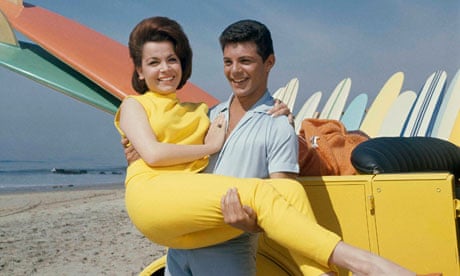Annette Funicello, who has died of complications from multiple sclerosis aged 70, was instantly associated with two names: Mickey Mouse and Frankie Avalon, both of whom were squeaky clean. As a child, Funicello was one of the first Mouseketeers on the original Mickey Mouse Club, the hugely popular Walt Disney children's television programme. In her early 20s, Funicello co-starred with the pop singer Avalon in five "Beach Party" musicals, in which they played wholesome "teenage" sweethearts called Dee Dee and Frankie, always testing each other's fidelity.
Born in Utica, New York, Funicello took ballet dancing lessons as a child to overcome shyness. In 1955, some years after her family had moved to southern California, the 12-year-old was chosen by Disney himself from 200 children auditioning for the first season of the Mickey Mouse Club. From 1955 to 1957, she danced, sang and acted in sketches while wearing the distinctive Mickey Mouse ears.
She soon became a favourite with viewers, and in 1958 was given her own 19-episode series called Annette. In it, Funicello played a sweet (but not sugary), unspoilt orphan girl from the country who goes to live with her aunt and uncle in the big city, and has to adapt to new surroundings and people. In one episode, she launched her singing career with How Will I Know My Love?, though she had more charm than vocal talent. It became the first of many hit singles, which included Tall Paul, O Dio Mio, Train of Love and It's Really Love, the last written by Paul Anka, whom she dated. In fact, he wrote the song Puppy Love (1959) – "I cry each night these tears for you" – when they broke up.
Disney then cast her in two live-action fantasy features, The Shaggy Dog (1959) and Babes in Toyland (1961), before allowing her, to everyone's surprise, to go to American International Pictures to make Beach Party (1963) on condition that she keep her virginal image, not wear a bikini and keep her navel covered. Nevertheless, she did bare her navel in all the films, and wore a bikini in Bikini Beach (1964).
With rock'n'roll movies a thing of the past and twist movies on their last swaying legs, the Beach Party films, made for the youth market, invariably involved a group of young, scantily clad surfers defending their right to continue their love-ins and gyrations to surf music without interference from killjoy "squares". However, Funicello, Avalon and the gang were no rebels without causes, but credits to the community.
The first film of the naive series, which opened with the title number sung by Funicello and Avalon, concerned an anthropology professor, Robert Cummings, studying the "mating habits" of the teenage denizens of Malibu beach. With not much sex to study, but to help his research, the professor makes an unthreatening play for Funicello, who is determined to make Avalon jealous and force him to marry her.
Avalon makes Funicello jealous in Muscle Beach Party (1964), in which the surfers clash with a group of musclemen sent to ruin the kids' fun. Bikini Beach had Keenan Wynn attempting to evict surfers from the beach and prove that his chimpanzee is more intelligent than the average American teenager. Beach Blanket Bingo and How to Stuff a Wild Bikini (both 1965) delivered more of the same. However, what was noticeable was how much Funicello became wittier, sharper and sexier with each picture … and her singing improved!
Away from the surf and sand, Funicello and Avalon were teamed up again for Fireball 500 (1966), in which he competes, on and off the stock car racing track, with a fellow driver for her affections. After Thunder Alley (1967), another schlocky stock car racing drama, Funicello retired from acting, apart from a self-deprecating cameo in Head (1968), featuring the Monkees, and guest appearances in TV series.
In 1987, Funicello and Avalon good-naturedly starred as a middle-aged couple in Back to the Beach, a likable spoof of those 60s hormonal musical comedies. Funicello, who gets to do a reggae number, is acidly described by her teenage son as "having been in a good mood for 22 years".
In 1992, Funicello announced that she had been diagnosed with multiple sclerosis. She had felt it necessary to go public to combat rumours that her difficulty in walking was the result of alcoholism. In 1993, she established the Annette Funicello Research Fund for Neurological Disorders at the California Community Foundation.
Funicello is survived by her second husband, Glen Holt, a racehorse breeder, and by three children, Gina, Jack and Jason, from her marriage to the casting director Jack Gilardi, which ended in divorce.

Comments (…)
Sign in or create your Guardian account to join the discussion